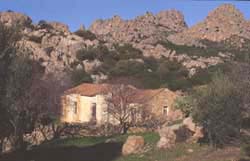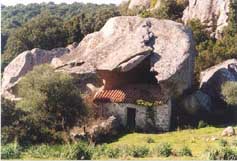| 15 | The Camillo Story |
Invasions of Sardinia
In
the centuries that followed, Sardinia often fell prey to passing pirates
and marauders, owing to its strategic position in the middle of the
Mediterranean sea. It is no
wonder therefore that most of the main Sardinian cities are inland, wary
as Sardinians were of the dangers that came from the sea. These raids in
fact continued right up to recent times, as some of the older folk used to
describe.
On
the Costa Smeralda, for example, the natural caves at Liscia di Vacca were
used as hiding places from the pirates by the Orecchioni family, just at
the turn of the century. The highest local peak, Monte Moro, is so called
because it provided a useful look-out against the Moors. Monte Canaglia (Rascal
Hill), is the name given to the place where the scoundrels settled down
and you can find traces in some local surnames, like Ragnedda,
"wicked like a spider" or in place names, Lu Saraghinu
"the Saracen", La Petra di li Tulchi, the rock where the Turks
set ashore.
There
is still memory in present day families of not too distant events, like
the mother who left her child on the beach to play, while she collected
berries close by. When she returned, she found the Saracens sailing off
with her child and in grief
lost all reason. She became known as "La scasciata d'Agnula Maria",
Mad Angle Maria. The Casalloni family that today resides in nearby San
Pantaleo, narrowly escaped a bitter fate for their two small children,
Stephen and Luke, who fortunately were not in their house but under a
nearby olive tree, when it was ravaged by the Moors. In thanksgiving they
made a donation to the church of an 18 century flag.


It
is curious to note a further indication of the natural fear of invaders
from the sea, that on the coast, the old Sardinian cottages never have a
sea view as they were always built in positions where they couldn't be
seen from the sea. Moreover, Sardinians completely lack a fishing
tradition and the few fishermen on the island are all migrants, or their
descendants, from the Pontine Islands, close to the mainland.
It
is an ironic quirk of fate, that today the recent economic prosperity of
Sardinia has actually come from the sea, from an invasion of many summer
tourists. This has also led to many intermarriages, with mainland Italians,
Germans, Swiss, English, French, Scandinavian and even with Australians.
Presently,
new waves are already beginning to come from the Eastern Block, Poland,
ex-Yugoslavia, Albania, Russia and even from Africa, with young blacks
selling their wares on the beaches. Certainly new romances will arise in
the discotheques and eventually marriages, that will vary further the
general genetic patrimony of the Sardinian population.
The
conclusion, therefore, is that the Sardinian people are characterised by a
very ancient stock, which remained cut off for thousands of years and was
then periodically injected with very different racial chromosomes. Their
mainland counterparts, on the other hand, during all this time had much
more opportunity of racial intermingling and therefore diversified
considerably. One can safely
say that modern mainland Italians are more closely related to say, the
Germans, than to Sardinians, notwithstanding that they live in the same
country and that twenty odd thousand years ago, they originated from the
very same tribes.
These
stories clearly show how racial types constantly change and develop,
either in peaceful intermarriage or through violence. Today we are a
product of the past and therefore to thoroughly know ourselves, it is
fundamental to know those that came before us. Another lesson to be learnt
is that racial hatred is pure folly, as we are all related at one point in
time or another and probably much closer than what we all think.
From
a language point of view, the Romans left the biggest mark in Sardinia and
today we find that the Sardinian language is heavily based on the Latin
language. In fact it is the best living example of what the Latin language
sounded like. The isolation of the central parts of Sardinia from outside
influences helped preserve their language over the last 2000 years.
Grammar
however, was another matter, that is if the Sardinians ever learnt it
properly in the first place. Dante Alighieri wrote that "the
Sardinians mimic Latin grammar, just like the monkeys mimic humans,
because they say 'domus nova et Dominus meus'.
The coastal areas of Sardinia, on the other hand, were very much influenced by the invading foreign forces: the Alghero area, by the Spanish Catalan dialect; the Gallura and Carloforte area, by the Genoan dialect and inflection.
Return to Menu of Camillo Story
l-camillo.com
Copyright L. Camillo 2000